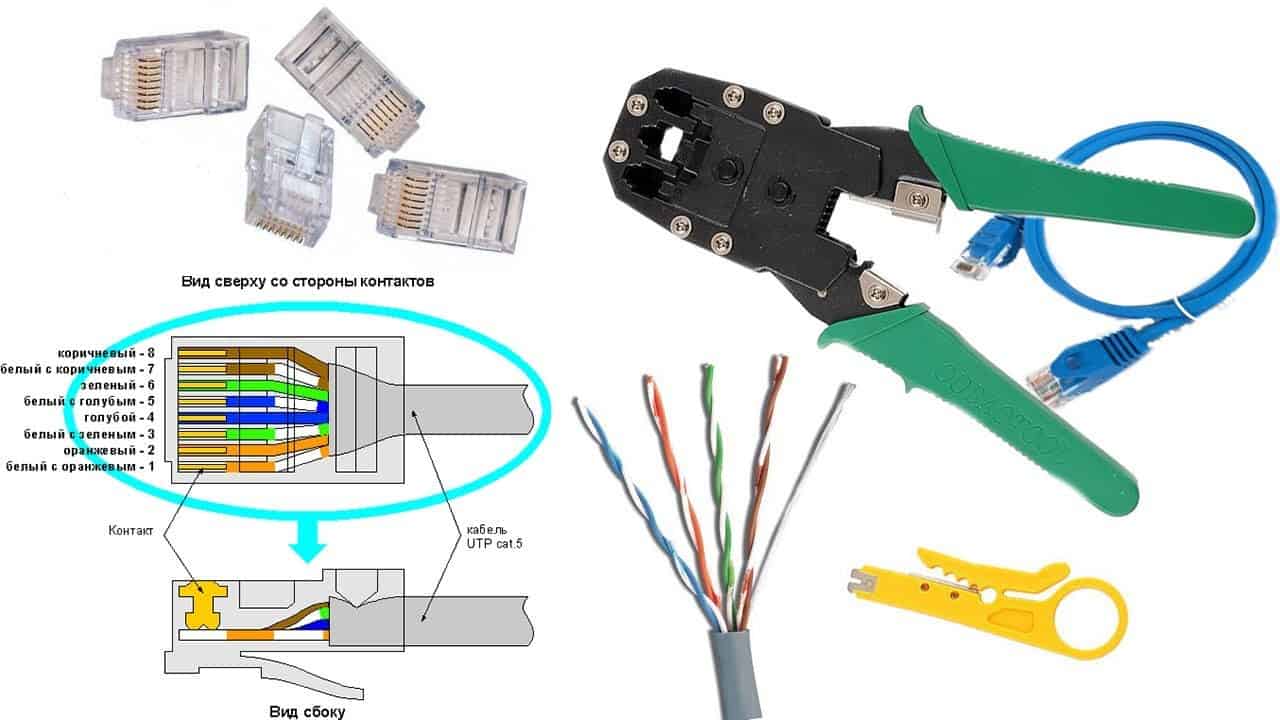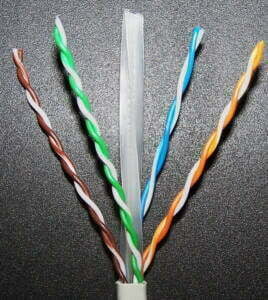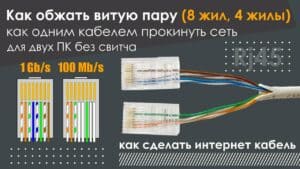Twisted pair: what is it?
Twisted pair is a cable used to transmit data in computer networks. It consists of several pairs of wires that are wound around each other in a spiral, forming 'coils'. Cable is made of copper or aluminum wires, usually insulated with plastic or rubber. Twisted pair cable is the best choice for data transmission for several reasons. Firstly, it provides high data transfer speeds. Secondly, the cable has a wide frequency range, which allows you to transmit signals over long distances without loss of quality. In addition, twisted pair cable is protected from electromagnetic interference, making it more reliable for data transmission. Twisted pair cable is used in various types of networks, including local area networks (LAN), wide area networks (WAN), Internet, and telephone networks. It is also used to connect computers to the Internet, as well as to transfer data between computers on a local network. In general, twisted pair cable is one of the most efficient and reliable methods of data transfer. If you are looking for a reliable way to connect computers to a network, then twisted pair is an excellent choice.
Main characteristics of twisted pair
Twisted pair is a cable that consists of two or more wires that are wrapped around each other. It was developed for the transmission of data and signals, and today is one of the most popular types of cables for communication networks.
The main characteristics of twisted pair include high data transfer speed, reliability and interference resistance. Twisted pair cable provides higher data transfer speeds than other types of cables such as coaxial cable or fiber optic cable.
In addition, twisted pair cable has a high degree of reliability and protection against interference. This provides higher quality data and signal transmission, making it a better choice for communication networks.
Twisted pair cable also has a low production cost, making it accessible to a wide range of users. The use of twisted pair cable for data transmission is the optimal solution for most communication networks, as it provides high data transfer speeds, reliability and protection from interference.
Working principle of twisted pair
Twisted pair is a cable that consists of two conductors twisted together into a spiral (coil). This method of assembling the cable helps reduce interference and noise that can occur during data transmission.
Each conductor in a twisted pair has its own color and purpose: one conductor transmits data (Tx), and the other receives (Rx). Therefore, a twisted pair is a symmetrical cable.
The principle of operation of a twisted pair is that the signals on each conductor change in antiphase. This means that when the signal is positive on one conductor, it is negative on the other conductor. This approach helps reduce noise and interference that may occur during data transmission.
In addition, twisted pair cables are protected from external electromagnetic interference, which can arise from other devices, cables, or even light and sound sources. This is achieved through the use of shielding in the form of foil or braid.
All these factors make twisted pair a better choice for data transmission compared to other types of cables. It provides high data transfer rates and minimizes errors, making it an ideal solution for modern communication networks.
How does twisted pair cable provide high data transfer rates?
One of the most common ways to transmit data is using twisted pair. But why is it the best choice for data transmission? The simplest reason is that twisted pair is a standard that is used in almost all networks.
Twisted pair cable provides high data transfer speeds because it consists of two conductors that are intertwined with each other. This minimizes signal interference and noise that may occur during data transmission.
In addition, twisted pair cable is highly resistant to external influences, such as electromagnetic radiation, which allows it to be used in networks with high device density.
Twisted pair also has great potential for expanding network capabilities. Due to its structure, it can be used to transmit various types of data, including video, voice and network status information.
Ultimately, using twisted pair cable to transmit data is a reliable and efficient method that allows for high transmission speeds and minimizes potential network disruptions.
Advantages of using twisted pair
Twisted pair is a cable that consists of two conductors twisted together. It is one of the most common types of data cables. And this is no coincidence. That's why:
1. Reliability: Twisted pair cable provides high reliability of data transmission. It is protected from interference and external influences, which allows it to maintain signal quality over long distances.
2. Speed: Twisted pair cable allows data to be transferred at high speeds. This is especially important for transferring large amounts of data, such as video or audio files.
3. Versatility: Twisted pair cable can be used to transmit various types of data, including voice, video and data.
4. Cost-effective: Twisted pair is one of the most affordable types of data cables. This makes it an ideal choice for many organizations and individual users.
Overall, using twisted pair cable for data transmission is the best choice due to its reliability, speed, versatility and cost-effectiveness.
Twisted pair is a pair of conductors that are twisted together to reduce electromagnetic interference and increase the throughput of transmitted data. This is why twisted pair cable is the best choice for data transmission in modern networks.
It is used to transmit data over Ethernet, telephone and other networks. Thanks to its design, twisted pair cables provide high data transfer speeds and minimal interference.
In addition, twisted pair allows you to transmit data over long distances without loss of signal quality. This is especially important for modern networks where large amounts of data need to be transmitted over long distances.
Another advantage of twisted pair is its cost. It is much cheaper than other types of data cables, making it an ideal choice for small and medium-sized businesses.
In general, choosing twisted pair for data transmission is the best solution for modern networks. It provides high data transfer speeds, minimal interference, the ability to transmit data over long distances and affordability.
How to install twisted pair cable correctly?
Installing twisted pair cabling is an important step in the process of creating a data network. Twisted pair cabling is a pair of wires that are used to transmit signals between different devices on a network. It is important to install twisted pair cabling correctly to ensure the best signal quality and minimal interference.
Twisted Pair Installation Steps:
1. Prepare the necessary tools, including a crimper, wire cutter and RJ45 connectors.
2. Cut the required length of twisted pair and remove the outer insulation about 2.5 cm from the end of the wire.
3. Separate the wires by color and arrange them according to the T568B standard.
4. Place the RJ45 connector on the end of the wire, then insert the wires into the corresponding holes in the connector.
5. Press the connector using a crimper so that the wires are securely fastened inside the connector.
By following these steps, you can install your twisted pair cable correctly and ensure that your network performs at its best.
Twisted Pair Installation Tips for Maximum Data Transfer Efficiency
Twisted pair installation is one of the most common methods of data transmission. However, to ensure maximum data transmission efficiency, the twisted pair cable must be installed correctly. Here are some tips to help you install twisted pair cable correctly:
- Select the correct cable type. There are different types of twisted pair cable, each with its own characteristics. For example, Category 5e is the most common and is suitable for most applications. However, if you plan to transfer a lot of data, you may want to consider higher category options, such as Category 6 or 6a.
- Route the cable correctly. Never lay the cable together with electrical wires or near other sources of electromagnetic interference. Also, do not bend the cable too sharply, as this may damage the cable and reduce the quality of data transmission.
- Connect the cable correctly. When connecting cables to network devices, make sure the wires are connected in the correct order. Incorrect connection may result in slow data transfer rates or complete signal loss.
- Use quality connectors. The cable must be connected to high quality connectors to ensure maximum data transfer efficiency. Poor quality connectors can result in signal loss or reduced data transfer rates.







